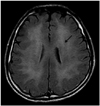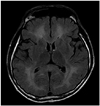Abstract
Occurrence of carbon monoxide intoxication has decreased due to decline in use of coal briquettes (anthracite) in Korea. However, suicide attempt by use of a coal fire lighter (beon-gae-tan) has shown a rapid increase over the past five years with relevance to imitated suicide. Acute carbon monoxide intoxication is a dangerous problem affecting the brain, kidney, lung, and other major organs. Sometimes, delayed encephalopathy after carbon monoxide intoxication makes clinical psychiatric diagnosis and treatment puzzling because neuropsychiatric sequelae are ambiguous with premorbid psychiatric problems, such as mood disorder, psychotic disorder, or other substance dependence. We report on a case of delayed encephalopathy of carbon monoxide intoxication and discuss its diagnosis and management.
Figures and Tables
References
1. Suh SJ, Min BS, Chung JH. Case Report : Neurological After - Effects Following Acute Carbon Monoxide Intoxication. Korean J Intern Med. 1961; 4:77–80.
2. Yoon CH. Neuropsychic sequelae of acute carbon monoxide poisoning. Korean J Intern Med. 1961; 4:71–75.
3. Lee MH. Clinical studies on delayed sequelae of carbon monoxide intoxication. J Korean Neuropsychiatr Assoc. 1978; 17:374–385.
4. Jang YJ. 'Samang' Kim Jong-hak PD kkaji...'Pongaetan chasal' wae panbok toena? The Asia Economy Daily. 2013. 07. 23. 25.
5. Park HS. 'Pongaetan' iyonghan chasal sido to isang pangchi an dwae. The Chosun Ilbo. 2013. 07. 26. 29.
6. Rodkey FL, O'Neal JD, Collison HA, Uddin DE. Relative affinity of hemoglobin S and hemoglobin A for carbon monoxide and oxygen. Clin Chem. 1974; 20:83–84.

7. Weaver LK, Hopkins RO, Chan KJ, Churchill S, Elliott CG, Clemmer TP, et al. Hyperbaric oxygen for acute carbon monoxide poisoning. N Engl J Med. 2002; 347:1057–1067.

8. Parkinson RB, Hopkins RO, Cleavinger HB, Weaver LK, Victoroff J, Foley JF, et al. White matter hyperintensities and neuropsychological outcome following carbon monoxide poisoning. Neurology. 2002; 58:1525–1532.

9. Choi IS. Delayed neurologic sequelae in carbon monoxide intoxication. Arch Neurol. 1983; 40:433–435.

11. Zhang J, Piantadosi CA. Mitochondrial oxidative stress after carbon monoxide hypoxia in the rat brain. J Clin Invest. 1992; 90:1193–1199.

12. Thom SR, Elbuken ME. Oxygen-dependent antagonism of lipid peroxidation. Free Radic Biol Med. 1991; 10:413–426.

13. Kim JH, Chang KH, Song IC, Kim KH, Kwon BJ, Kim HC, et al. Delayed encephalopathy of acute carbon monoxide intoxication: diffusivity of cerebral white matter lesions. AJNR Am J Neuroradiol. 2003; 24:1592–1597.
14. Choi I, Oh YH, Kim GT. Magnetic resonance imaging for the prediction of delayed neuro-psychiatric sequelae in patients with carbon monoxide poisoning. J Korean Soc Emerg Med. 2013; 24:164–173.
15. Meigs JW, Hughes JP. Acute carbon monoxide poisoning; an analysis of one hundred five cases. AMA Arch Ind Hyg Occup Med. 1952; 6:344–356.
16. Tintinalli JE, Stapczynski JS, Ma OJ, Cline D, Cydulka R, Meckler G. Tintinalli's emergency medicine: a comprehensive study guide. New York: McGraw-Hill Medical;2011.
17. Stephen RA, Donal SW, Siobhain OB, Michael CR, Daniel CJ. Carbon monoxide poisoning: novel magnetic resonance imaging pattern in the acute setting. Int J Emerg Med. 2012; 5:30.

18. Beppu T, Nishimoto H, Ishigaki D, Fujiwara S, Yoshida T, Oikawa H, et al. Assessment of damage to cerebral white matter fiber in the subacute phase after carbon monoxide poisoning using fractional anisotropy in diffusion tensor imaging. Neuroradiology. 2010; 52:735–743.

19. Lin WC, Lu CH, Lee YC, Wang HC, Lui CC, Cheng YF, et al. White matter damage in carbon monoxide intoxication assessed in vivo using diffusion tensor MR imaging. AJNR Am J Neuroradiol. 2009; 30:1248–1255.

20. Chang CC, Chang WN, Lui CC, Wang JJ, Chen CF, Lee YC, et al. Longitudinal study of carbon monoxide intoxication by diffusion tensor imaging with neuropsychiatric correlation. J Psychiatry Neurosci. 2010; 35:115–125.

21. Lam SP, Fong SY, Kwok A, Wong T, Wing YK. Delayed neuropsychiatric impairment after carbon monoxide poisoning from burning charcoal. Hong Kong Med J. 2004; 10:428–431.




 PDF
PDF ePub
ePub Citation
Citation Print
Print




 XML Download
XML Download